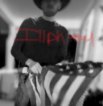illphated
The Girl Who Gave the Rocket Its Trajectory
Elsie Mae didn’t look like a woman who mapped the cosmos. In the sun-bleached poster above the feed store, she stood triumphant in her sturdy overalls, bandana tied tight, gazing past the plume of a stylized rocket. The caption promised: “From Our Fields to the Frontiers of Space!”
The poster was a lie, but it was the most beautiful lie Elsie Mae had ever believed.
Her own hands knew only the feel of rough cotton and sun-baked loam. She knew the sky, too, not as a frontier, but as a silent, unforgiving clock. On the farm outside Lubbock, the stars were just cold pinpricks of light that confirmed another day of back-breaking work lay ahead. Yet, it was the only education she needed. Alone on the porch after supper, she charted the slow, perfect march of Orion across the southern bowl, her mind translating stellar drift into geometry.
The letter came in a thick, official envelope that smelled of carbon paper and ambition. It offered her a position as a “Computer” at the new Jet Propulsion Laboratory in California. Not an engineer, not a scientist, but a human machine. She kissed her mother goodbye, folded the tattered propaganda poster neatly into her trunk, and traded the wheat field for a desk piled high with logarithmic tables.
The laboratory was sterile, smelling of ozone and coffee. Elsie Mae and forty other women sat in endless rows, their pencils flying across graph paper, checking the equations written by the young men in suits. They were the anonymous, essential gears in the nation’s great celestial engine.
One spring night, the engineers filed out, their faces pale with fatigue. They were stuck on a trajectory calculation for the P−7 prototype—a rocket that was meant to be a beacon of American potential, the very vessel shown on her poster. The margin of error was too wide; the whole flight was ill-fated before launch.
Elsie Mae, forgotten in the corner, didn’t move. She just stared at the equations. She didn’t have a degree, but she had spent a lifetime calculating harvest yields, wind shear, and the exact moment the moon would crest the silo. She remembered the angle of the wheat when the dust storms blew in, the way the geometry of the curve changed depending on the wind speed.
She saw the flaw. It wasn’t in the fuel mixture or the thrust; it was a basic angular miscalculation, a simple rounding error in a number that defined the very shape of the flight path.
She quietly scrawled the correction—a single, elegant line of chalk—on the board, corrected the complex polynomial, and walked out before the engineers returned.
The P−7 launched three weeks later. It was flawless. It arced into the midnight blue, a tiny metallic spear against the vast curtain of night. It was the moment the propaganda poster had promised.
Elsie Mae stood on a distant hill, not in the wheat field, but beside a cracked asphalt road. She watched the rocket ascend until it became just another cold, pinprick of light. The headlines the next morning lauded the lead engineer and his triumphant “genius.” There was no mention of the correction, no mention of the nameless woman who had saved the trajectory with the ghost of a farmer’s intuition.
She was the quiet geometry that had bridged the field to the frontier. She had given the rocket its wings, yet she remained firmly grounded, her name a forgotten calculation in the vast ledger of the heavens.
EmailURL







0vdbzt
u7runp
afuj3s